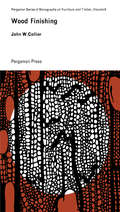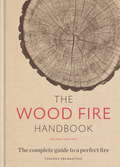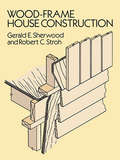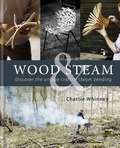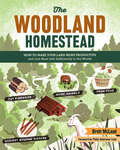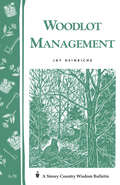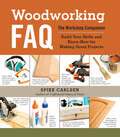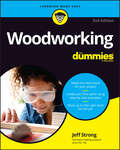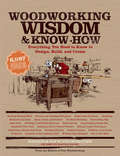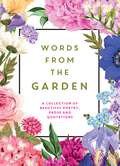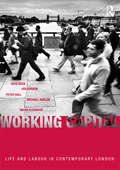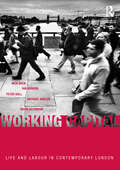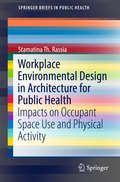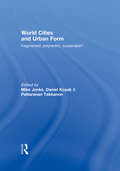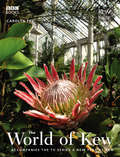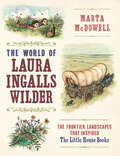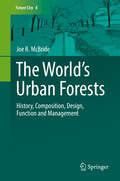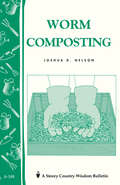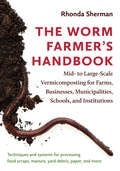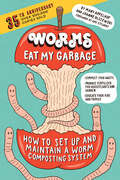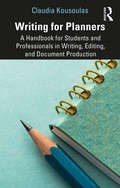- Table View
- List View
Wood Finishing: Pergamon Series of Monographs on Furniture and Timber
by John W. CollierWood Finishing provides a comprehensive guide to wood finishing. The emphasis of the book is on tackling practical topics. The text first details the material components of wood finishing, such as strippers, revivers, stoppers, and varnishes. Next, the selection covers the various processes in wood finishing, which include waxing, filling, spraying, and flatting. The next chapter talks about supplementary topics, such as the chemistry of timber, hazards, workshop practices, and testing finishes. The title also tackles the various tools utilized in wood finishing, which include brushes, spray paints, coating machines, and tumbling barrels. The book will be of great use to anyone who wants to expand knowledge in woodworking.
The Wood Fire Handbook: The complete guide to a perfect fire
by Vincent Thurkettle'Sound, well-seasoned advice [on] how to bring wood fires into our lives.' - BBC CountryfileThe Wood Fire Handbook shows you that the soothing effect of dancing flames and glowing embers is a simple pleasure to have in our lives. Understanding everything that underpins the perfect wood fire makes it even more enjoyable. Vincent Thurkettle's handbook is the essential companion and manual.The expert insight and knowledge in this book allow everyone to rediscover the skills of previous generations and savour the delight of a perfect wood fire in all its incarnations.Contents include...Understand which trees make the best firewoodLearn how to split, season, and store woodLay the perfect fireMake an ingenious campfireChoose wood for its scent...and much more!This revised edition features updated information on wood-burning stoves, 'clean' wood and other environmental considerations.
Wood-Frame House Construction: A Do-it-yourself Guide
by Gerald E. Sherwood Robert C. StrohFirst published in 1955 as U.S. Department of Agriculture Handbook No. 73, this highly popular guide presents sound, time-tested principles for wood-frame house construction, complete with expert advice on selecting suitable building materials. For this edition, it has been completely revised and updated to incorporate advances in home building brought about by the availability of new materials, use of more manufactured components, and changes in construction techniques. Chapter 1 covers the preliminaries that should be considered or dealt with before beginning construction ― financial planning, site selection, design, etc.Chapters 2–4 discuss laying the groundwork (including foundations, footings, and retaining walls), framing and closing in ― describing each step in the order it is usually completed. Chapters 5–7 describe later tasks that don't necessarily have to be done in the order they are presented. Topics include porches, decks, interior wall framing, plumbing, heating and electric installation, flooring, interior finishes, cabinets, and more. Chapter 8 covers special topics often associated with wood-frame construction: protection against decay and termites, energy conservation, all-weather construction, maintenance and repair, and other matters. Technical notes, an annotated list of suggestions for additional reading, and a glossary round out the book. Clear, thorough, and easy to follow, with nearly 200 helpful illustrations, Wood-Frame House Construction offers a detailed, informative guide to construction techniques invaluable for the do-it-yourselfer or as a review for the professional.
Wood & Steam: Discover The Unique Craft Of Steam Bending
by Charlie WhinneyIn this beautifully compiled book, Charlie Whinney, the UK's leading expert on the topic, shares the secrets of the unique and magical craft of steam-bending. Although his creations look quite impossible, you will soon discover that wood can be made to behave in remarkable ways with the application of a little heat and steam. Charlie guides you through the ecological sourcing of wood for your projects and then, with practical instructions, reveals how to create your own steam-bent masterpieces. Form a wooden coathanger in the embers of a campfire, create perfectly round wooden hoops using just a saucepan and a mug, or use your new skills to craft a stunning rocking chair.With step-by-step instructions and inspiring photography from Charlie's workshop in the Lake District, this will make the perfect gift for anyone interested in developing a new skill.
The Woodland Homestead: How to Make Your Land More Productive and Live More Self-Sufficiently in the Woods
by Brett McLeodFrom shelter to food to fuel and more, The Woodland Homestead gives you all the tools and information you need to sustainably use your woodlot to its fullest potential.
Woodlot Management: Storey's Country Wisdom Bulletin A-70 (Storey Country Wisdom Bulletin)
by Jay HeinrichSince 1973, Storey's Country Wisdom Bulletins have offered practical, hands-on instructions designed to help readers master dozens of country living skills quickly and easily. There are now more than 170 titles in this series, and their remarkable popularity reflects the common desire of country and city dwellers alike to cultivate personal independence in everyday life.
Woodworking FAQ: The Workshop Companion: Build Your Skills and Know-How for Making Great Projects
by Spike CarlsenWhether you&’re a beginner building your first shelf or an experienced craftsman designing a new gazebo, Spike Carlson has the answers to all of your woodworking questions. You&’ll find expert advice on setting up your work area, choosing appropriate tools, working with different types of wood, and building furniture, as well as tips on joinery techniques, custom finishes, and much more.
Woodworking For Dummies
by Jeff StrongMake stunning furniture, shelves, and more, with this easy guide Woodworking For Dummies gives aspiring woodworkers step-by-step instructions for creating successful woodworking projects. Set your sights on creating beautiful wooden pieces, with your own two hands. Woodworking is a fun and fascinating hobby, and you’ll love developing your skills and enjoying the satisfaction of craftsmanship. This book explains, in simple terms, the basic tools you’ll need, the different types of wood you can work with, and the process of creating plans for a successful project. Start sawing, sanding, joining, and finishing wood projects you can be proud of. One-of-a-kind, handmade woodcrafts are excellent as additions to your home and gifts for others, and you can even start a small business selling your handiwork. This For Dummies primer makes this cool activity accessible to anyone. Start a new hobby, work with your hands, and see your visions come to life Learn about classic and cutting-edge woodworking tools Differentiate between the different kinds of wood and select the right materials for your project Become a woodworker with easy-to-use photos and instructions Even if you’ve never picked up a saw before, this For Dummies guide will help you get started—and it’s a great reference and refresher for those who already know what they’re doing, too.
Woodworking For Dummies
by Jeff StrongMake stunning furniture, shelves, and more, with this easy guide Woodworking For Dummies gives aspiring woodworkers step-by-step instructions for creating successful woodworking projects. Set your sights on creating beautiful wooden pieces, with your own two hands. Woodworking is a fun and fascinating hobby, and you’ll love developing your skills and enjoying the satisfaction of craftsmanship. This book explains, in simple terms, the basic tools you’ll need, the different types of wood you can work with, and the process of creating plans for a successful project. Start sawing, sanding, joining, and finishing wood projects you can be proud of. One-of-a-kind, handmade woodcrafts are excellent as additions to your home and gifts for others, and you can even start a small business selling your handiwork. This For Dummies primer makes this cool activity accessible to anyone. Start a new hobby, work with your hands, and see your visions come to life Learn about classic and cutting-edge woodworking tools Differentiate between the different kinds of wood and select the right materials for your project Become a woodworker with easy-to-use photos and instructions Even if you’ve never picked up a saw before, this For Dummies guide will help you get started—and it’s a great reference and refresher for those who already know what they’re doing, too.
Woodworking Wisdom & Know-How: Everything You need to Design, Build and Create (Wisdom & Know-How)
by Taunton PressFrom the experts at Fine Woodworking magazine, this complete and easy-to-follow resource has everything you need to know about the art of woodworking.Woodworking Wisdom & Know-How is the essential go-to book for every woodworking project imaginable, from building kitchen cabinets to refinishing a deck, from the vast cache of Fine Woodworking's projects and advice.Topics addressed in this book include:Types of WoodBuilding a WorkshopWorking and Finishing WoodDesign and StylesSmall and Large ProjectsEach section is further broken down into chapters that cover specific skills, projects, and crafts for both the beginner and the advanced woodworker. Featuring step-by-step instructions, troubleshooting guides and discussions, and an appendix of essential resources for supplies, tools, and materials, Woodworking Wisdom & Know-How is your one-stop-shop for trusted, tried, and true woodworking advice.This book is also a part of the Know-How series which includes other titles such as:Country Wisdom & Know-HowNatural Healing Wisdom & Know-HowCraft Wisdom & Know-HowGarden Wisdom & Know-How
Words From the Garden: A Collection of Beautiful Poetry, Prose and Quotations
by Isobel CarlsonThis beautiful collection of poetry and prose through the seasons rhapsodises on the spectacle of colour and everything green and flourishing in the garden. The perfect book for a moment’s reflection, whether you are cooped up on a rainy day in your potting shed or admiring the fruits of your labour on a sunny evening from the pergola.
Working Capital: Life and Labour in Contemporary London
by Nick Buck Ian Gordon Peter Hall Michael Harloe Mark KleinmanFor decades the cities of the developed world were seen as problem-beset relics from times of low mobility and slow communications. But now, their potential to sustain creativity, culture and innovation is perceived as crucial to success in a much more competitive global ecomony. The vital requirement to secure and sustain this success is argued to be the achievement of social cohesion.Working Capital provides a rigorous but accessible analysis of these key issues taking London as its test case. The book provides the first substantial analysis of key economic, social and structural issues that the new London administration needs to deal with. In a wider context, its critical assessment of the bases of the new urbanism and of the global city thesis will raise questions both about the adequacy of urban thinking and about the capacity of new institutions alone to resolve the fundamental problems faced by cities.
Working Capital: Life and Labour in Contemporary London
by Nick Buck Ian Gordon Peter Hall Michael Harloe Mark KleinmanFor decades the cities of the developed world were seen as problem-beset relics from times of low mobility and slow communications. But now, their potential to sustain creativity, culture and innovation is perceived as crucial to success in a much more competitive global ecomony. The vital requirement to secure and sustain this success is argued to be the achievement of social cohesion.Working Capital provides a rigorous but accessible analysis of these key issues taking London as its test case. The book provides the first substantial analysis of key economic, social and structural issues that the new London administration needs to deal with. In a wider context, its critical assessment of the bases of the new urbanism and of the global city thesis will raise questions both about the adequacy of urban thinking and about the capacity of new institutions alone to resolve the fundamental problems faced by cities.
Working Cities: Architecture, Place and Production
by Howard DavisCities have historically supported production, commerce, and consumption, all central to urban life. But in the contemporary Western city, production has been hidden or removed, and commerce and consumption have dominated. This book is about the importance of production in the life of the city, and the relationships between production, architecture, and urban form. It answers the question: What will cities be like when they become, once again, places of production and not only of consumption? Through theoretical arguments, historical analysis, and descriptions of new initiatives, Working Cities: Architecture, Place and Production argues that contemporary cities can regain their historic role as places of material production—places where food is processed and things are made. The book looks toward a future that builds on this revival, providing architectural and urban examples and current strategies within the framework of a strong set of historically-based arguments. The book is illustrated in full colour with archival and contemporary photographs, maps, and diagrams especially developed for the book. The diagrams help illustrate the different variables of architectural space, urban location, and production in different historical eras and in different kinds of industries, providing a compelling visual understanding for the reader.
Workplace Environmental Design in Architecture for Public Health: Impacts on Occupant Space Use and Physical Activity (SpringerBriefs in Public Health)
by Stamatina Th. RassiaThis concise volume analyzes the potential for the workplace environment—where so many people spend so much of their day—to improve workers’ capacity for health and wellness. It pinpoints the link between sedentary lifestyles and poor health, and explores the role of office spatial design in encouraging physical activity to promote physical activity, health and prevent disease. The featured research study tracks workers’ movement in a variety of office layouts, addressing possible ways movement-friendly design can co-exist with wireless communication, paperless offices, and new corporate concepts of productivity. From these findings, the author’s conclusions extend public health concepts to recognize that influencing population-wide levels of activity through office architectural design alone may be possible. This SpringerBrief is comprised of chapters on : Physical activity and disease: Theory and practice Space-use and the history of the office building Identifying factors of the office architectural design that influence movement, Interdisciplinary research methods in studying worker physical activity, decision-making and office design characteristics The KINESIS model for simulating physical activity in office environmentsThe questions and potential for solutions in Workplace Environmental Design in Architecture for Public Health will interest and inform researchers in interdisciplinary topics of public health and architecture as well as graduate and post-graduate students, architects, economists, managers, businesses as well as health-conscious readers.
World Cities and Urban Form: Fragmented, Polycentric, Sustainable?
by Mike Jenks Daniel Kozak Pattaranan TakkanonThis book presents new research and theory at the regional scale showing the forms metropolitan regions might take to achieve sustainability. At the city scale the book presents case studies based on the latest research and practice from Europe, Asia and North America, showing how both planning and flagship design can propel cities into world class status, and also improve sustainability. The contributors explore the tension between polycentric and potentially sustainable development, and urban fragmentation in a physical context, but also in a wider cultural, social and economic context.
World Cities and Urban Form: Fragmented, Polycentric, Sustainable?
by Mike Jenks Daniel Kozak Pattaranan TakkanonThis book presents new research and theory at the regional scale showing the forms metropolitan regions might take to achieve sustainability. At the city scale the book presents case studies based on the latest research and practice from Europe, Asia and North America, showing how both planning and flagship design can propel cities into world class status, and also improve sustainability. The contributors explore the tension between polycentric and potentially sustainable development, and urban fragmentation in a physical context, but also in a wider cultural, social and economic context.
The World of Kew
by Carolyn FryWithout plants, there would be no life on earth. Kew Gardens is famous for its breathtaking displays of flowers and tree,s but this World Heritage Site is also a globally important scientific and historical organization. Scientists and gardeners use the plants and knowledge that have been collected at Kew since the eighteenth century to advance understanding of the earth's environment and of how plant lfe can be used for human benefit. Published to accompany the ten-part BBC2 series A New Year at Kew, this fascinating book takes us behind the scenes to show the extraordinary range of work carried out at Kew Gardens and Wakehurst Place - home to the Millenium Seed Bank - and by Kew staff overseas. From using forensic botant to micropagating plants facing extinction, from investigating herbal cures from Alzheimer's disease to replanting the volcano-ravaged island of Montserrat, the book shows us aspects of Kew's work that are largely hidden from view abut the benefits of which are far reachingl In the process it provides an absorbing and accessible introduction to such topical subjects as biodiversity, practical conservation and economic botany. Lavishly illustrated and filled with engrossing stories and engaging characters, this book brings to life the world of Kew and the global importance of its work.
The World of Laura Ingalls Wilder: The Frontier Landscapes that Inspired the Little House Books
by Marta McDowellLushly illustrated with beloved images and quotations from the Little House series, The World of Laura Ingalls Wilder, by New York Times bestselling author Marta McDowell, examines and celebrates Wilder&’s unique relationship with the American frontier.
The World’s Urban Forests: History, Composition, Design, Function and Management (Future City #8)
by Joe R. McBrideThe purpose of this book is to examine urban forests in cities around the world. It will ask questions about the history, composition, structure, and management of trees in urban areas. Data for this book was collected in 33 cities across broad geographical areas known as biomes. Constraints and opportunities imposed on urban forest composition, design, and management by the ecological characteristics of these biomes will be examined. The book will also address the cultural and historical factors that influenced the characteristics of urban forests around the world.
Worm Composting: Storey's Country Wisdom Bulletin A-188 (Storey Country Wisdom Bulletin)
by Joshua D. NelsonSince 1973, Storey's Country Wisdom Bulletins have offered practical, hands-on instructions designed to help readers master dozens of country living skills quickly and easily. There are now more than 170 titles in this series, and their remarkable popularity reflects the common desire of country and city dwellers alike to cultivate personal independence in everyday life.
The Worm Farmer’s Handbook: Mid- to Large-Scale Vermicomposting for Farms, Businesses, Municipalities, Schools, and Institutions
by Rhonda ShermanTechniques and systems for processing food scraps, manure, yard debris, paper, and more Turning waste into wealth sounds too good to be true, but many worm farmers are finding that vermicomposting is a reliable way to do just that. Vermicast—a biologically active, nutrient-rich mix of earthworm castings and decomposed organic matter—sells for $400 or more per cubic yard. Compare that to regular compost, sold at about $30 a cubic yard, and you’ll see why vermicomposting has taken root in most countries and on every continent but Antarctica. Vermicomposting is also one of the best sustainable solutions for organic waste management. Vermicomposting manure and crop wastes on farms improves crop yields while reducing demand for off-farm inputs. Vermicast has higher nutrient levels and lower soluble salt content than regular compost, and it improves soil aeration, porosity, and water retention. Plus, vermicast suppresses plant diseases and insect attacks. Municipalities, businesses, community gardens, schools, and universities can set up vermicomposting operations to process food residuals and other waste materials. The Worm Farmer’s Handbook details the ins and outs of vermicomposting for mid- to large-scale operations, including how to recycle organic materials ranging from food wastes and yard trimmings to manure and shredded office paper. Vermicomposting expert Rhonda Sherman shares what she has learned over twenty-five years working with commercial worm growers and researchers around the world. Her profiles of successful worm growers across the United States and from New Zealand to the Middle East and Europe describe their proven methods and systems. This book digs into all the details, including: Choosing the right production system Regulatory issues and developing a business and marketing plan Finding and managing feedstocks Pre-composting: why and how to do it Monitoring an active worm bed Harvesting, screening, testing, packaging, and storing vermicast Markets for earthworms and vermicast Food security: how vermicast benefits soils and plants Keys to success: avoiding common pitfalls From livestock farms and restaurants to colleges, military bases, and prisons, Sherman details why and how commercial-scale vermicomposting is a fast-growing, sustainable solution for organic waste management. The Worm Farmer’s Handbook is the first and only authoritative how-to guide that goes beyond small-scale operations and demystifies the science and logistics of the fascinating process that is vermicomposting.
Worms Eat My Garbage, 35th Anniversary Edition: How to Set Up and Maintain a Worm Composting System: Compost Food Waste, Produce Fertilizer for Houseplants and Garden, and Educate Your Kids and Family
by Mary Appelhof Joanne OlszewskiFor more than three decades, this best-selling guide to the practice of vermicomposting has taught people how to use worms to recycle food waste into nutrient-rich fertilizer for houseplants or gardens. Small-scale, self-contained worm bins can be kept indoors, in a basement, or even under the kitchen sink in an apartment — making vermicomposting a great option for city dwellers and anyone who doesn&’t want or can&’t have an outdoor compost pile. The fully revised 35th anniversary edition features the original&’s same friendly tone, with up-to-date information on the entire process, from building or purchasing a bin (readily available at garden supply stores) to maintaining the worms and harvesting the finished compost.
Worship Space Acoustics: 3 Decades of Design
by David T. Bradley Erica E. Ryherd Lauren M. Ronsse“Worship Space Acoustics: 3 Decades of Design is a beautiful collection of recent work. This is a comprehensive compendium that far surpasses previous publications in the field in its depth, design, and information. Worship spaces of all major U.S. religions are covered. This book should be an obligatory reference for any consultant involved in church architecture and acoustics.”-Mendel Kleiner, author of Worship Space Acoustics, Acoustics: Information and Communication Series (J. Ross Publishing 2010)“All involved in their design will appreciate this presentation of recent rooms for religious worship.” -Leo L. Beranek, author of Concert Halls and Opera Houses: Music, Acoustics, and Architecture (Springer-Verlag 2004)“Through descriptions, photos, drawings, and acoustical data, this book provides valuable information on existing worship spaces designed during the past thirty years. This very well-edited book, including the Editors' Preface and six excellent essays from key people involved in worship space design, provides valuable information and ideas on the aesthetic, acoustic, and liturgical design of worship spaces for a number of faiths and in several countries.”-Robert Coffeen, principle at R. C. Coffeen, Consultant in Acoustics LLC, Lawrence, KansasThis book takes the reader on a wide-ranging tour through churches, synagogues, mosques, and other worship spaces designed during the past 30 years. The book begins with a series of essays on topics ranging from the soundscape of worship spaces to ecclesiastical design at the turn of the 21st Century. Perspective pieces from an architect, audio designer, music director, and worship space owner are also included. The core of the book presents the acoustical and architectural design of a wide variety of individual worship space venues. Acoustical consulting firms, architects, and worship space designers from across the world contributed their recent innovative works in the area of worship space acoustics. The contributions include detailed renderings and architectural drawings, as well as informative acoustic data graphs and evocative descriptions of the spaces. Filled with beautiful photography and fascinating modern design, this book is a must-read for anyone interested in religious architecture, acoustical design, or musical performance.
Writing for Planners: A Handbook for Students and Professionals in Writing, Editing, and Document Production
by Claudia KousoulasWriting is never easy, but this book can make it easier. With attentiveness and experience, Claudia Kousoulas gives readers applied writing, editing, and production approaches that provide a clear path to completing a document and tools that ensure it is engaging and professional. The book follows a project’s path from initial assignment and conception, through sorting out what’s significant, shaping it into a message, and guiding readers to an action. It addresses the different types of documents planners have to create, the different media they use, and the different audiences they address. Its strategies will help writers start a project and see it through to a clear and coherent piece of work that serves its purpose. This book will help planners meet the challenges of creating work that is accurate, creative, and useful. Students will find it helpful in providing professional standards and quick reference information, and professionals will carry it through their careers as a reference, and as a way to establish workplace standards and improve their own work.
